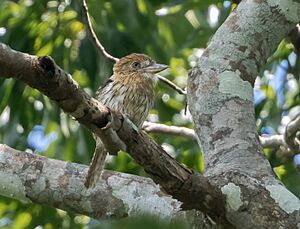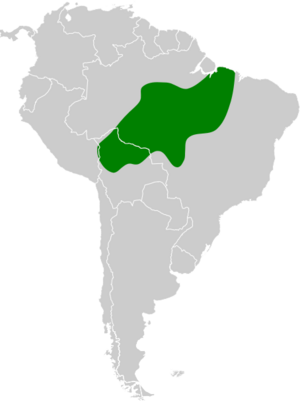Eastern striolated puffbird facts for kids
Quick facts for kids Eastern striolated puffbird |
|
|---|---|
 |
|
| Conservation status | |
| Scientific classification | |
| Genus: |
Nystalus
|
| Species: |
striolatus
|
 |
|
The eastern striolated puffbird (Nystalus striolatus) is a cool bird that belongs to a group called Bucconidae. This family includes puffbirds, nunlets, and nunbirds. You can find this bird living in parts of Bolivia and Brazil.
Contents
About This Bird
How Scientists Name Birds
Scientists often study birds closely to understand them better. Sometimes, they find that what they thought was one species is actually two or more! This happened with the striolated puffbird. What was once called just "striolated puffbird" was split into two different species: the eastern striolated puffbird and the western striolated puffbird.
After this discovery, the original bird was renamed the "eastern striolated puffbird." It has two types, called subspecies: N. s. striolatus and N. s. torridus. It's a bit like having different breeds of dogs, but for birds!
What It Looks Like
The eastern striolated puffbird is about 20 cm (7.9 in) long, which is about the length of a regular pencil. It weighs around 43 to 47 g (1.5 to 1.7 oz), which is lighter than a tennis ball.
It has a dark brown head with reddish-brown stripes. A wide, light brown collar sits around its neck. Below that, it has a dark band. The rest of its back is dark brown with reddish-brown spots and stripes. Its tail is thin and dark brown with light reddish stripes.
Around its eyes, it has a white spot, and the rest of its face is light brown with thin dark streaks. Its chin is white, and its throat is a yellowish-brown color with fine dark streaks. The middle of its belly is whiter and doesn't have any streaks. Its beak is mostly olive green, and its eyes are a pale yellowish-brown.
Where It Lives
The eastern striolated puffbird lives in the central part of the Amazon Basin. You can find it in Brazil, especially between the Madeira and Tapajós rivers. It also lives in the very northeastern part of Bolivia, in the Santa Cruz Department.
The other type, N. s. torridus, lives in northeastern Amazonian Brazil, south of the Amazon River and east of the Tapajós River.
This bird likes to live in different kinds of forests, including the edges of humid tropical forests, dry forests, and swamp forests. It also likes forests where different types of trees meet. You'll often find it near water or open areas, usually staying in the middle or top parts of the trees. This bird doesn't travel far from its home.
How It Behaves
What It Eats
Scientists haven't fully studied what the eastern striolated puffbird eats or how it finds food. However, most puffbirds are known to be good hunters. They usually sit on a branch and then quickly fly out to catch large insects or small animals from leaves or tree bark.
How It Raises Its Young
We don't know much about how the eastern striolated puffbird breeds. But other birds in its family often make their nests in tunnels dug into the ground.
What It Sounds Like
The eastern striolated puffbird has a special song. It's described as a "soft, sad whistle" that sounds like 'whip, whiwheeu, wheeeeeuu'. The two different subspecies have slightly different songs.
Its Status in the Wild
The eastern striolated puffbird is currently listed as a species of "Least Concern" by the IUCN. This means it's not considered to be in danger of disappearing. It lives across a very large area. While its exact population size isn't known, it's thought that the number of these birds might be slowly going down. However, it's quite common in some parts of Brazil and lives in several protected areas, which helps keep it safe.


